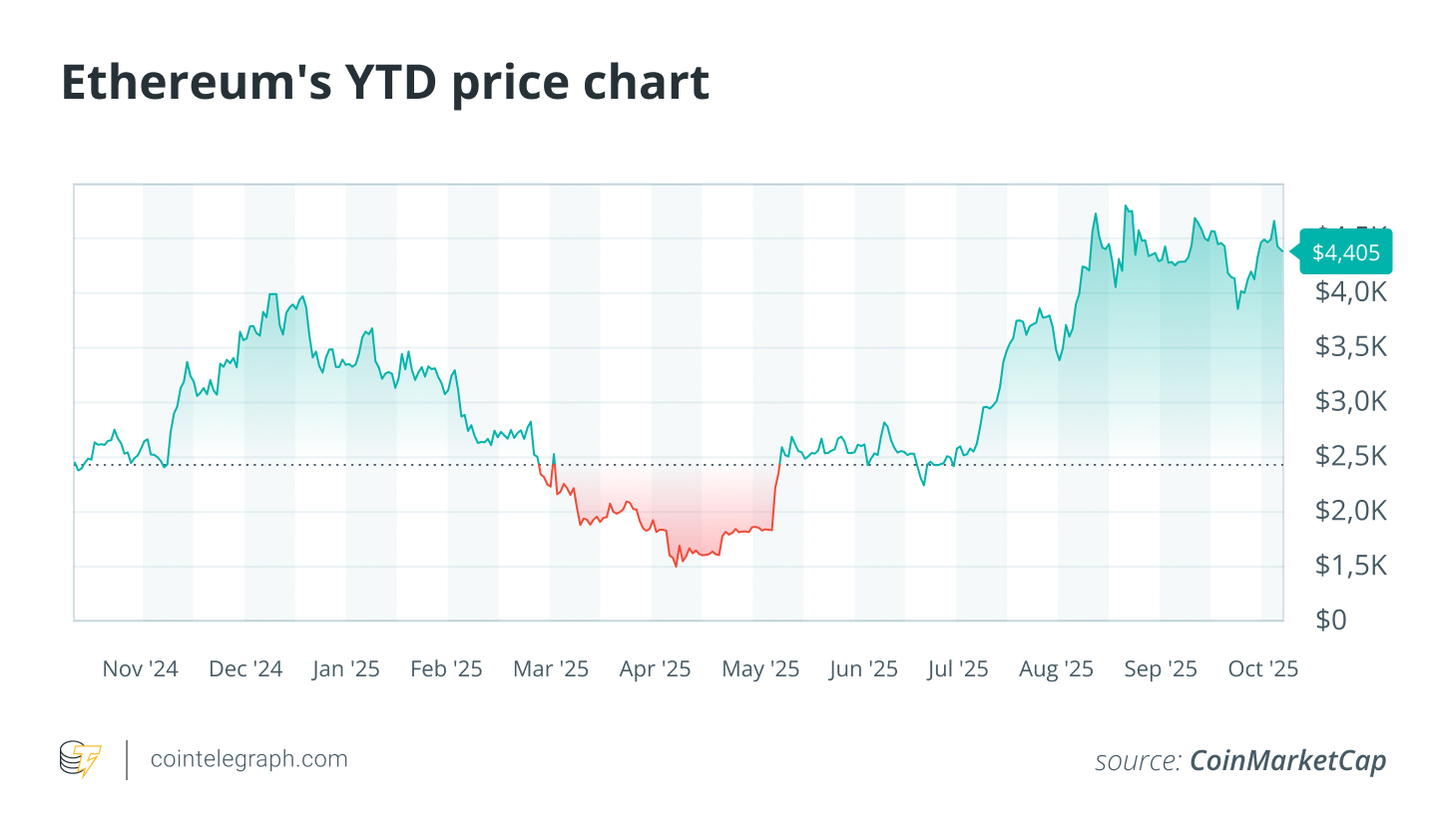
What would Ethereum’s Price at $100,000 Mean?
If Ether (ETH) reaches a price of $100,000, this would propel Ethereum into a multitrillion-dollar valuation with significant ramifications.
At this price point, the current circulating supply of 121.1 million ETH would suggest a market capitalization of approximately $12.1 trillion, exceeding Apple’s market cap by 3.2 times and representing about 44% of gold’s total estimated value.
With around 36 million ETH potentially remaining staked (29.5% of the total supply), this would account for $3.6 trillion in locked capital. The implications of achieving such a status would dramatically elevate every key performance metric, enhancing staking rewards, transaction fees in US dollars, and the collateral backing decentralized finance (DeFi) and ETFs.
This piece will not only examine how ETH could realistically achieve the $100,000 price level, but also what a multitrillion-dollar economy would entail in practice.
 Ethereum
Ethereum
Did you know? VanEck notably projected ETH reaching prices above $100,000, sharing a 2030 valuation model that estimated a bullish price of $154,000 per ETH, and a conservative case of $22,000.
Translation: Did you know? VanEck made a significant call for Ethereum to surpass $100,000, forecasting a valued estimate for 2030.
What Drives ETH to $100,000?
Achieving this six-figure valuation hinges on multiple sustainable factors.
-
A Reliable Institutional Appetite: Significant interest in spot ETH funds indicates the potential for broader allocation from various financial institutions including pensions and retirement accounts.
-
Increased On-chain Activity: With stablecoins reaching record levels around $300 billion and collateralized US Treasury funds emerging, Ethereum’s liquidity is deepening as more daily transactions are conducted on the network.
-
Sensible Scaling Solutions: The Dencun upgrade has facilitated a more economical method for publishing transactions, keeping user fees low, while still maintaining value through the ETH network.
-
Higher Scarcity Mechanisms: The amount of staked ETH crossing 36 million tightens available supply, intensifying market dynamics as transaction fees result in ETH being burned.
-
Macro-Economic Variables: Current predictions place ETH’s price range from $7,500 to $25,000 between 2025 and 2028, with a $22,000 base expectation for 2030. Crossing into six-figure territory would necessitate optimal conditions across ETFs and inflowing capital.
The journey for ETH to reach $100,000 cannot rely solely on short-term hype; it requires consistent trends and strategic institutional investments.
Ethereum Network Economics at $100,000
At six-figure valuations, minute changes within the network could translate into massive shifts in dollar value, which supports network security.
Ethereum’s proof-of-stake system links new issuance to the stake in the network, enabling the rewards to scale effectively without excessive inflation. When ETH sits at $100,000, the real measure becomes the dollar value of those rewards.
For example, at this price point:
- 100,000 ETH issued annually equates to $10 billion.
- 300,000 ETH results in $30 billion.
- 1 million ETH leads to $100 billion.
These funds contribute alongside priority fees and maximal extractable value (MEV) stemming from block production.
Maintaining Ethereum Usability at $100,000
Users are likely to tolerate a price of $100,000 for ETH only if daily transaction costs remain affordable, maintaining Ethereum’s value capture.
Gas fees at this price would translate to much higher costs in USD terms. The Dencun upgrade facilitates the use of Rollups, lowering costs while transactions still settle in ETH, leading to a balanced ecosystem where ETH remains integral.
Consistent user activity will be crucial to uphold $100,000; affordable L2s support retail and business transactions, ensuring sustained demand, and the ongoing burning of ETH enhances scarcity.
Sources of $100,000 Flows: ETFs, DeFi, Stablecoins
The buyers and their methods will delineate the market dynamic at this price point rather than just headlines.
- ETFs as Structural Buyers: Spot funds ensure predictable creations, promoting steady demand without depleting liquidity.
- DeFi’s Contribution: Price escalations enhance borrowing capacity, while increasing risk exposure during volatile market conditions.
- Stablecoins Play: Facilitating everyday transactions while supporting low fees across Ethereum leads to deeper market liquidity.
Together, stable buying patterns from ETFs and vibrant network activity propel ETH toward sustainability and valuation growth.
What Could Prevent a $100,000 Outcome?
Achieving and maintaining such large valuations intensifies everything, from volatility to regulatory challenges. Key aspects include:
- Swift Reactions and Leverage Risks: Market conditions can lead to rapid liquidations, intensifying downward pressure.
- Enhanced Regulatory Scrutiny: Increased monitoring of staking and other financial products may affect flows.
- Concentration Risks: High centralization and shared dependencies create additional systemic risks.
- User Experience and Security Standards: Balancing between layer 1 and layer 2 experiences will be crucial for engaging users.
Ultimately, the sustainability of a $100,000 ETH will depend on diverse operators, prudent risk management, and effective client mechanisms aligning with steady growth indicators.



